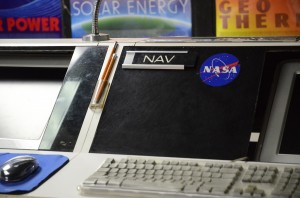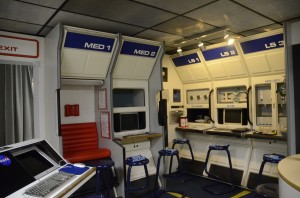W
ASHINGTON—When the shuttle Atlantis touched down at the Kennedy Space Center Thursday, more than three decades of NASA’s space shuttle program ended. ram. . But the programs that introduced students to the space shuttle aren’t planning on going anywhere.

The Challenger Learning Center of the Prince Georges County Public Schools in Lanham, Md., has taken children to space since 1989. (Gabrielle Levy/MNS)
For many children growing up in the past 30 years, the shuttle program was more than emblematic of space exploration, it was the inspiration to pursue fields in aerospace, engineering, and other sciences
“Lots of people saw the space shuttle as one of NASA’s primary projects, but we have lots of other things that we do that are involved in education,” said Jeff Ehmen, an administrator of education at NASA’s Marshall Space Flight Center. “They’re all exciting in their own right.”
Ehmen said that education programs out of Marshall will continue to operate, even as some of the facilities dedicated to the propulsion elements of shuttle flight that were handled at Marshall are repurposed for NASA’s other projects.
NASA coordinates weeklong Astro Camp sessions for pre-teens and teens, supports the FIRST Robotics competition in which 25-person teams of high school students compete to build the best robot, and runs a number of student activities and professional development programs with an eye to raising a new generation of scientists and engineers—or just curious and engaged citizens of the world.
“Nothing will replace the space shuttle as we knew it but there are other exciting things that will touch teachers and students,” Ehmen said.
In addition to programs run out of NASA facilities, independent and partner organizations such as Space Camp, run by the U.S. Space and Rocket Center in Huntsville, or the national network of Challenger Learning Centers also have committed to continue their work.

Children perform tasks to successfully complete "missions" to Mars, the moon, or the International Space Station. (Gabrielle Levy/MNS)
At its Learning Center, the nonprofit, founded in 1986 after Challenger exploded moments after launch, runs simulated “missions” to the International Space Station, the moon, or Mars, giving students an interactive experience of space travel.
“It’s not just dress up, you’re actually making decisions,” said Dave Zahren, a space science educator and meteorologist in Maryland. “It is what science education could be and should be.”
Zahren, who was one of 114 teachers nationwide chosen to compete for a berth aboard the ill-fated Challenger mission, said the end of the shuttle program leaves a gap of opportunity in science education.
Particularly as schools struggle with shrinking budgets, students get less laboratory exposure and do more of their learning virtually, Zahren said, programs like the Challenger Learning Centers stimulate students’ interest in science and technology.
“As the space shuttle program ends, the opportunity for kids to grow up to be astronauts is over, for now,” he said. “What will we do next?”
President Barack Obama has charged NASA with exploring deep space and focusing on unmanned travel as it retires the space shuttle and eventually develops a replacement vehicle. Francis Eberle, the executive director of the National Science Teachers Association, said students will benefit from a more innovative approach to the study of space.
“The NASA human space flight program was an icon of American technology, but it represents a past.” Eberle said. “There are still plenty of space-related phenomena that are amazing. Those kinds of things really get kids thinking.”
